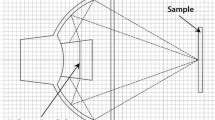Abstract
A new test procedure was developed to proof the strength of engineering ceramics under biaxial loading. This test procedure enables a simultaneous loading of thin-walled tubular specimen by using internal hydraulic pressure and an axial force. This leads to a wide range of biaxial stress states of combined tension/compression stresses. First test results of silicon carbide show the usefulness of the test setup. It will be used to perform comprehensive investigations of engineering ceramics. The evaluated biaxial strength behaviour and an additional investigation of the fracture toughness of engineering ceramics should lead to a probabilistic modeling of ceramic failure under multiaxial loading.
Access this chapter
Tax calculation will be finalised at checkout
Purchases are for personal use only
Preview
Unable to display preview. Download preview PDF.
Similar content being viewed by others
References
Broutman, L.J., Krishnakumar, S.M., and Mallik, P.K., Effects of Combined Stresses on Fracture of Alumina and Graphite. J Amer. Ceram. Soc., 1970, 53, 649–654.
Ely, R.E., Strength of Titania and Alumina Silicate Under Combined Stresses. J Amer. Ceram. Soc., 1972, 55, 347–350
Adams, M., and Sines, G., Determination of Biaxial Compressive Strength of Sintered Alumina Ceramics. J. Amer. Ceram. Soc., 1976, 59, 300–304.
Tappin, G., Davidge, R.W., McLaren, J.R., The Strength of Ceramics under Biaxial Stresses. 3. Int. Symp. on Fracture Mech. of Ceramics, Flaws and Testing, ed. R.C. Bradt, D.P.H. Hasselman and F.F. Lange, Plenum Press, New York — London, 1978, Vol. 3, pp. 435–449.
Petrovic, J.J. and Stout, M.G., Fracture of Al2O3 in Combined Tension/Torsion: I. Experiment, J. Amer. Ceram. Soc., 1981, 64, 656–660.
Petrovic, J.J. and Stout, M.G., Fracture of Al2O3 in Combined Tension/Torsion: II. Weibull Theory. Ibid, 661–686.
Shetty, D.K., Rosenfield, A.R., Duckworth, W.H., and Held, P.R., A Biaxial-Flexure Test for Evaluating Ceramic Strength. J. Amer. Ceram. Soc., 1983, 66, 36–42.
Godfrey, D.J., and John, S., Disc Flexure for the Evaluation of Ceramic Strength. In Ceramic Materials and Components for Engines. Proceedings of the Second International Symposium, Luebeck-Travemuende, FRG, Verlag Deutsche Keramische Gesellschaft, 1986, pp. 657–665.
Author information
Authors and Affiliations
Editor information
Editors and Affiliations
Rights and permissions
Copyright information
© 1992 Elsevier Science Publishers Ltd and MPA Stuttgart
About this chapter
Cite this chapter
Staskewitsch, E., Stiebler, K., Burblies, A., Arone, R. (1992). Testing of Engineering Ceramics under Biaxial Loading. In: Carlsson, R., Johansson, T., Kahlman, L. (eds) 4th International Symposium on Ceramic Materials and Components for Engines. Springer, Dordrecht. https://doi.org/10.1007/978-94-011-2882-7_54
Download citation
DOI: https://doi.org/10.1007/978-94-011-2882-7_54
Publisher Name: Springer, Dordrecht
Print ISBN: 978-1-85166-776-5
Online ISBN: 978-94-011-2882-7
eBook Packages: Springer Book Archive




